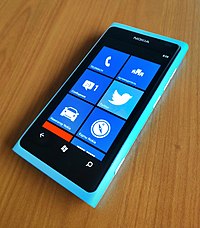 | |
| Manufacturer | Nokia[1] |
|---|---|
| Availability by region | November 2011 (Europe) December 2011 (Worldwide) March 2012 (Australia, Brazil) |
| Successor | Nokia Lumia 820[2] |
| Related | Nokia Lumia 710 Nokia Lumia 900 Nokia N9 |
| Compatible networks | Lumia 800 2G GSM GSM/GPRS/EDGE – 850, 900, 1800, 1900 MHz 3G WCDMA/HSDPA – 850, 1900, 2100 MHz Lumia 800C (Mainland China only) 2G CDMA – 800, 1900 MHz; GSM/GPRS– 850, 900, 1800, 1900 MHz (International roaming only, including Hong Kong, Macau and Taiwan) 3G CDMA2000[3] |
| Form factor | Slate |
| Dimensions | 116.5 mm (4.59 in) H 61.2 mm (2.41 in) W 12.1 mm (0.48 in) D |
| Weight | 142 g (5.0 oz) |
| Operating system | Windows Phone 7.5, updateable to Windows Phone 7.8[4] |
| System-on-chip | Qualcomm Snapdragon S2 MSM8255T |
| CPU | 1.4 GHz single-core Qualcomm Scorpion |
| GPU | Qualcomm Adreno 205 |
| Memory | 16 GB internal flash 512 MB ROM 512 MB RAM |
| Battery | Rechargeable BV-5JW 3.7v 1450 mAh Li-ion battery:
|
| Rear camera | 8-megapixel, 3264x2448 pixels, dual-LED flash, autofocus Carl Zeiss optics, 720p video capture |
| Front camera | None |
| Display | 3.7" ClearBlack, Gorilla Glass AMOLED PenTile[5] at 252 ppi capacitive touchscreen 480x800 px 16M-color WVGA |
| Connectivity | Bluetooth 2.1, 802.11b/g/n, G-Sensor, Digital Compass, A-GPS, micro-USB, 3.5mm audio jack |
| Data inputs | Multi-touch capacitive touchscreen, proximity sensor, ambient light sensor, 3-axis accelerometer, digital compass, 2 microphones[6] |
| Other | Available in cyan, magenta, black and white[7] |
| Website | Nokia Lumia 800 Archive |
The Nokia Lumia 800, which was codenamed 'Sea Ray', is a smartphone that was launched by Nokia on October 26, 2011, at the Nokia World 2011 event.[8] Initially, it operated on Snapdragon S2 processor and Windows Phone 7.5 "Mango" and was the first device manufactured by Nokia to run on the Windows Phone operating system. This marked a significant shift for the company from using Symbian for their smartphones. Upon its original release in November 2011 in Europe, it was Nokia's flagship product and was hence a crucial product for their mobile phone business.[9][10][11]
Lumia 800 shares its design with the previously released MeeGo-based Nokia N9 and it was originally Meego CDMA-variant for Verizon with codename RM-716 Searay.[12] The outward differences are one added physical button dedicated to the camera on the right side of the phone, and a dual LED flash moved directly above the Carl Zeiss camera lens.[13] Despite a similar exterior, the Lumia 800 has a different interior than N9. Lumia 800's chipset comes from Qualcomm S2 processor, whereas the N9 is based on a Texas Instruments OMAP chipset and CPU.[14] Like the N9, it has a convex-curved Gorilla Glass AMOLED PenTile screen with a ClearBlack antiglare filter. The screen diagonal is 3.7 inches (800 x 480 pixels), compared with 3.9 inches (854 x 480 pixels) for N9, to conform with the Windows Phone specifications list, which includes three capacitive softkeys placed under the glass. A through-colored unibody shell is made from polycarbonate plastic.[1]
It was replaced as the flagship by Nokia Lumia 900, which was originally released for the American market through AT&T before its worldwide release.[15] On 5 September 2012, the Nokia Lumia 820, the successor of the Nokia Lumia 800, was presented. The improvements are Windows Phone 8, dual core processor, front camera, wireless charging option, exchangeable covers, and bigger screen.[2]
- ^ a b Detailed specifications for the Nokia Lumia 800 Archived 12 December 2012 at the Wayback Machine Nokia
- ^ a b Nokia Lumia 820 smartphone revealed – Specifications
- ^ Nokia Lumia 800C specifications
- ^ "It's official: No WP8 for existing Lumia Phones, instead WP7.8 update ~ Nokia For Us". Archived from the original on 24 July 2014. Retrieved 27 June 2012.
- ^ Cite error: The named reference
Sherifwas invoked but never defined (see the help page). - ^ "Device details – Nokia Lumia". Nokia Developer. 6 March 2012. Archived from the original on 29 April 2013. Retrieved 6 May 2013.
- ^ Trevor Davies. "White Nokia Lumia 800 out soon". Nokia. Archived from the original on 9 November 2013. Retrieved 13 March 2012.
- ^ Toor, Amar (26 October 2011). "Nokia announces the Lumia 800". Engadget. Retrieved 26 October 2011.
- ^ Warman, Matt (12 November 2011). "Lumia launch: a make or break week for Nokia". The Telegraph. Retrieved 6 October 2018.
- ^ Garside, Juliette (23 November 2011). "Nokia Lumia 800 'set to trail iPhone 4S'". The Guardian. Retrieved 6 October 2011.
- ^ "Nokia launches Windows phones Lumia 800, 710 in India". Business Today. 14 November 2011. Retrieved 14 April 2024.
- ^ Kurri, Sampsa (3 January 2013). "English version: After the story of Nokia MeeGo (part 2)". Muropaketti. Otavamedia. Retrieved 6 October 2018.
- ^ "Lumia 800 Specs & Latest News | Nokia". The Verge. Archived from the original on 7 October 2018. Retrieved 14 June 2013.
- ^ "Upcoming Nokia N9 vs. iPhone 4". Archived from the original on 4 January 2012. Retrieved 16 March 2012.
- ^ Miles, Stuart (23 January 2012). "Nokia Lumia 900 UK release in June, says Carphone Warehouse". Pocket-link. Retrieved 6 October 2018.